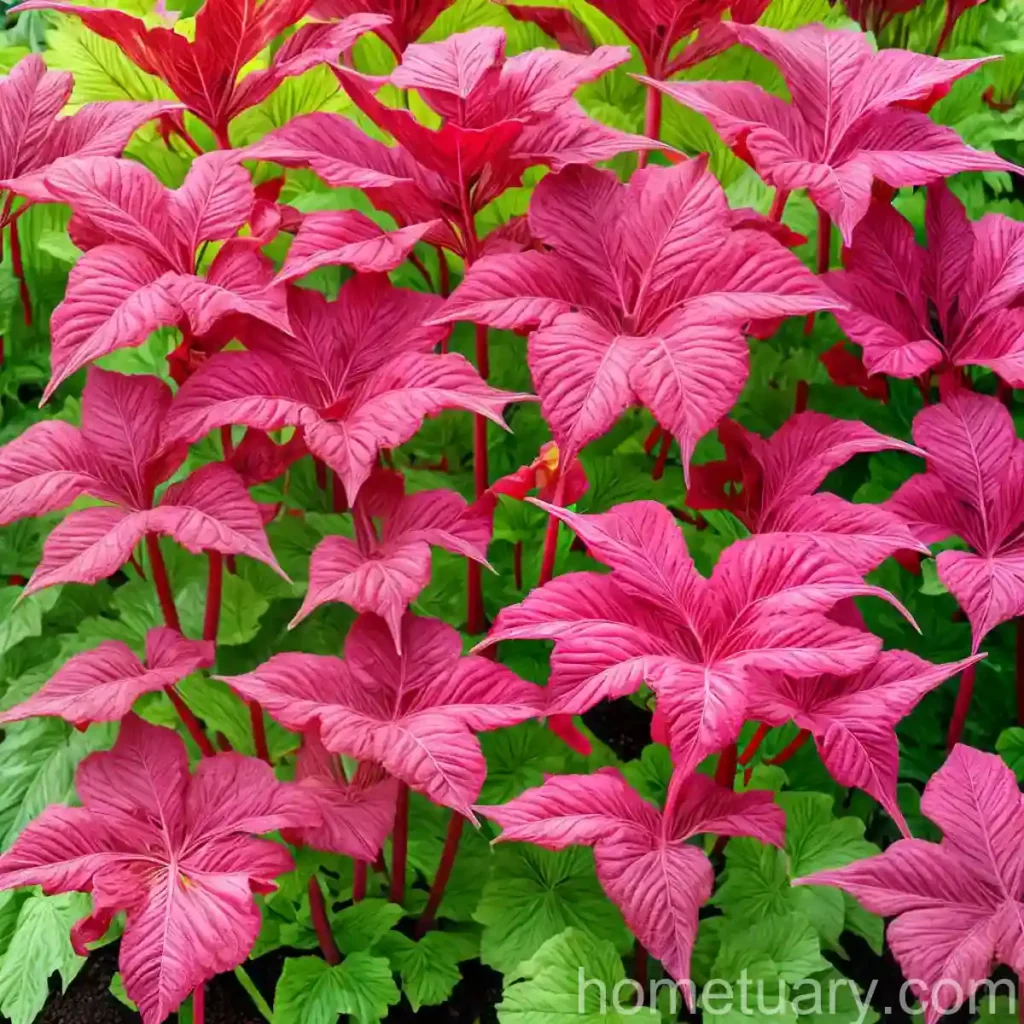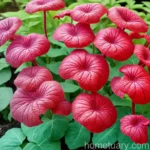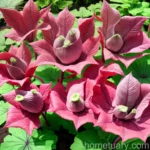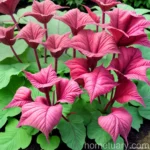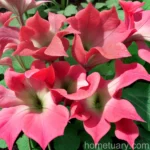Chinese Rhubarb (Rheum palmatum): A Comprehensive Guide
Rheum palmatum, commonly known as Chinese rhubarb, is a species of flowering plant in the family Polygonaceae. This plant has a rich history of cultivation and usage in traditional medicine, culinary practices, and ornamental landscaping. In this comprehensive guide, we will explore the cultural, medicinal, and horticultural aspects of Chinese rhubarb, providing valuable insights for both amateur gardeners and plant enthusiasts.
What is Plant: Chinese Rhubarb (Rheum palmatum)
Chinese rhubarb, scientifically known as Rheum palmatum, is a perennial herbaceous plant native to the regions of China and Tibet. It is characterized by its large, ornamental leaves and vibrant red stalks. In traditional Chinese medicine, the rhizomes of Chinese rhubarb have been widely used for their medicinal properties, contributing to its significance as an herb of substantial cultural and economic value.
Key Takeaways – Chinese Rhubarb (Rheum palmatum)
Before delving into the intricate details of Chinese rhubarb cultivation, uses, and care, let’s highlight the key takeaways of this fascinating plant:
- Botanical Name: Rheum palmatum
- Common Name: Chinese rhubarb
- Family: Polygonaceae
- Cultural Significance: Traditional Chinese medicine, culinary use, ornamental landscaping
- Growth Habit: Perennial herbaceous plant with large, lobed leaves and red stalks
- Medicinal Uses: Known for its therapeutic effects and health benefits in traditional medicine
- Horticultural Value: Popular for its ornamental appeal and resilience as a garden plant
Now, let’s explore the various aspects of cultivating and caring for Chinese rhubarb, from its cultural significance to its horticultural requirements.
Culture
Uses
Medicinal Uses
One of the most prominent aspects of Chinese rhubarb is its extensive application in traditional medicine. The rhizomes of Rheum palmatum contain bioactive compounds that are known for their therapeutic effects and medicinal benefits. Some of the key medicinal uses of Chinese rhubarb, supported by historical and contemporary literature, include:
- Digestive Health: Chinese rhubarb is often used to promote digestive health and alleviate various gastrointestinal issues.
- Detoxification: It is utilized as a natural detoxifying agent, aiding in the elimination of toxins from the body.
- Anti-inflammatory Properties: The plant possesses anti-inflammatory properties and is used to reduce inflammation in the body.
- Liver Function: It is believed to support liver function and enhance hepatic detoxification processes.
- Traditional Herbal Remedies: Chinese rhubarb is a key ingredient in various traditional herbal remedies and medicinal preparations.
Culinary Uses
In addition to its medicinal significance, Chinese rhubarb has culinary applications, particularly in traditional Chinese cuisine. The stalks of Chinese rhubarb are known for their tart flavor and are used in a range of culinary creations, including:
- Desserts: Stewed rhubarb is a popular dessert ingredient, often used in pies, crumbles, and compotes.
- Preserves: Chinese rhubarb is used to make jams, jellies, and preserves, enhancing its tartness with sweeteners.
- Flavoring: The acidic and tangy taste of Chinese rhubarb is utilized to add depth of flavor to various dishes and beverages.
Water
Chinese rhubarb, being a resilient plant, exhibits moderate water needs. It thrives in well-draining soil and requires regular watering to keep the soil consistently moist. However, it is essential to avoid waterlogging and excessive moisture, as this can lead to root rot and other water-related issues.
Watering Tips for Chinese Rhubarb:
– Ensure the soil is consistently moist, but not waterlogged.
– Water deeply, allowing the moisture to reach the root zone, especially during dry spells.
– Avoid overhead watering to prevent leaf diseases and fungal infections.
Sunlight
Chinese rhubarb flourishes in environments with ample sunlight, preferably receiving full to partial sun exposure. Adequate sunlight is crucial for the development of its large, vibrant leaves and robust growth.
Sunlight Requirement:
– Place Chinese rhubarb in a location that receives at least 6-8 hours of sunlight per day.
– Ensure that the plant is shielded from excessive heat or prolonged exposure to intense afternoon sun, especially in warmer regions.
Fertilizer
When it comes to fertilizing Chinese rhubarb, it is important to provide balanced nutrition to support its vigorous growth and overall health. A slow-release, organic fertilizer is recommended to avoid the risk of over-fertilization and to provide a steady supply of nutrients.
Fertilizing Guidelines:
– Use a balanced fertilizer with a lower nitrogen content to promote strong root development and leaf growth.
– Apply fertilizer in early spring before new growth emerges, following the recommended dosage.
– Refrain from over-fertilizing, as excessive nitrogen can lead to lush foliage at the expense of sturdy stalks.
Soil
Chinese rhubarb thrives in well-draining, fertile soil with a slightly acidic to neutral pH range. The soil should be rich in organic matter and capable of retaining moisture without becoming waterlogged.
Ideal Soil Conditions:
– Choose a loamy, well-draining soil with a pH range of 6.0 to 6.8 for optimal growth.
– Incorporate organic compost or well-rotted manure into the soil to improve its texture and nutrient content.
– Ensure good soil aeration and avoid compacted or heavy clay soils, as they can impede root development.
Pruning
Pruning Chinese rhubarb is essential to maintain the plant’s vigor and prevent overcrowding. It involves the removal of dead or decaying foliage, as well as the division of large, congested clumps to promote healthier growth.
Pruning Techniques:
– Remove any yellowing or withered leaves to maintain the plant’s aesthetic appeal and overall health.
– Divide overcrowded rhubarb clumps every 4-5 years to prevent competition for nutrients and space.
– Cut off any flower stems that emerge to redirect the plant’s energy towards leaf and stalk production.
Propagation
Propagating Chinese rhubarb can be achieved through several methods, including division, seed sowing, and root cuttings. Each propagation technique has its advantages and considerations, depending on the desired outcome and the resources available to the gardener.
Propagation Methods:
1. Division: Divide mature rhubarb plants in early spring or late autumn to create new, independent plants.
2. Seed Sowing: Start seeds indoors in early spring and transplant the seedlings once they have developed several true leaves.
3. Root Cuttings: Cut sections of the rhizome with viable buds and plant them in a prepared bed for root establishment.
Container Popularity
Chinese rhubarb is increasingly popular as a container plant due to its ornamental appeal, compact growth habit, and suitability for small gardens and urban spaces. Growing Chinese rhubarb in containers allows for greater control over its growing conditions, especially in areas with limited outdoor space.
Benefits of Container Cultivation:
– Suitable for balconies, patios, and small gardens with restricted planting space.
– Enables gardeners to provide specific soil and water conditions tailored to the plant’s requirements.
– Facilitates the management of plant size and growth, preventing the spread of the rhizomes beyond desired limits.
Container Common Diseases
When growing Chinese rhubarb in containers, it is essential to be vigilant about potential diseases that can affect the plant. Several common diseases, including fungal infections and leaf spot diseases, can impact container-grown Chinese rhubarb if proper care and preventive measures are not implemented.
Common Diseases in Container-Grown Chinese Rhubarb:
1. Botrytis Blight (Gray Mold): A fungal disease characterized by gray fuzzy growth on the leaves and stems, often affecting plants in humid conditions.
2. Leaf Spot Diseases: Various fungal pathogens can cause leaf spot, leading to the development of circular or irregular lesions on the foliage.
3. Root Rot: Excessive moisture in container soil can create conducive conditions for root rot pathogens, leading to wilting and decay of the root system.
Disease Diagnosis
Diagnosing diseases in Chinese rhubarb is crucial for implementing timely and effective control measures. An accurate diagnosis allows for the selection of appropriate treatment methods and preventive strategies to protect the plant from further damage.
Diagnosis Techniques:
– Inspect the foliage and stems for signs of discoloration, spotting, or abnormal growth patterns.
– Monitor changes in plant growth and vigor, noting any wilting, stunted growth, or decline in overall health.
– Seek professional advice or utilize resources from reputable plant pathology sources to accurately identify specific diseases.
Common Pests
While Chinese rhubarb is relatively resilient to most pests, certain insect pests can pose a threat to its foliage and overall health. By understanding the common pests that affect Chinese rhubarb, gardeners can implement effective pest management strategies to mitigate potential damage.
Common Pests Affecting Chinese Rhubarb:
1. Aphids: These small, soft-bodied insects can infest the undersides of rhubarb leaves, causing damage through feeding and the secretion of honeydew.
2. Spider Mites: These tiny arachnids can cause stippling and discoloration on the foliage, leading to weakened plant vigor.
3. Rhubarb Curculio: This weevil species can cause damage by feeding on the petioles and leaf stems, leading to wilting and distortion.
Botanist’s Tips
As a plant scientist with a deep understanding of the botanical aspects of Chinese rhubarb, I highly recommend the following tips for cultivating and caring for this fascinating plant:
Botanist’s Tips for Chinese Rhubarb Cultivation:
1. Choose a well-draining location with ample sunlight and adequate air circulation for optimal growth.
2. Incorporate organic matter into the soil to enhance its fertility and water retention capacity.
3. Prune Chinese rhubarb regularly to remove dead foliage and maintain plant vigor.
4. Implement integrated pest management strategies to prevent and manage common pests in a sustainable manner.
5. Monitor soil moisture levels and water Chinese rhubarb consistently to support healthy growth without waterlogging.
Fun Facts
Delving into the realm of fun and intriguing facts about Chinese rhubarb can further deepen our appreciation for this remarkable plant and its cultural significance. Let’s explore some captivating fun facts about Chinese rhubarb:
Fascinating Fun Facts about Chinese Rhubarb:
1. Chinese rhubarb has been cultivated for centuries for its medicinal properties and has a prominent place in traditional Chinese medicine.
2. The bright red stalks of Chinese rhubarb are rich in compounds with a range of therapeutic effects, contributing to its time-honored use in herbal remedies.
3. The tart flavor of Chinese rhubarb lends itself to a variety of culinary creations, from pies and preserves to infused beverages and sauces.
4. Chinese rhubarb is celebrated for its ornamental value, adorning gardens with its lush foliage and vibrant stalks.
5. The use of Chinese rhubarb as a medicinal herb extends beyond traditional medicine, with applications in contemporary herbal supplements and wellness products.
Links to External Resources
For those seeking further information and in-depth resources on Chinese rhubarb, here are valuable links to external sources providing comprehensive insights into various aspects of Rheum palmatum:
- Rheum palmatum benefits and medicinal uses
- Culinary uses and properties of Chinese rhubarb
- Horticultural aspects and cultivation practices for Rheum palmatum
- Traditional and contemporary uses of Chinese rhubarb in herbal medicine
- Botanical description and growth habits of Rheum palmatum
In conclusion, Chinese rhubarb (Rheum palmatum) stands as a captivating plant with a rich tapestry of cultural, medicinal, and horticultural significance. Whether it’s harnessing its medicinal properties, savoring its tart taste in culinary creations, or admiring its ornamental allure, Chinese rhubarb continues to captivate and inspire enthusiasts across the globe.
As a plant scientist, I have painstakingly crafted this comprehensive guide to shed light on the multifaceted nature of Chinese rhubarb, emphasizing its botanical, cultural, and practical dimensions. Feel free to explore the references and immerse yourself in the captivating world of Rheum palmatum.

